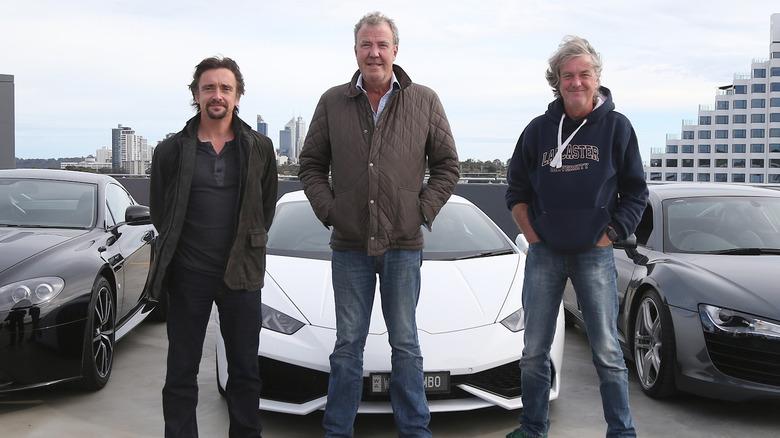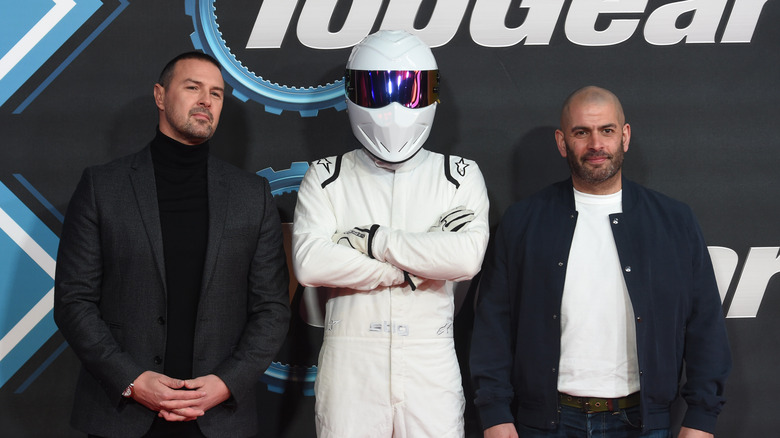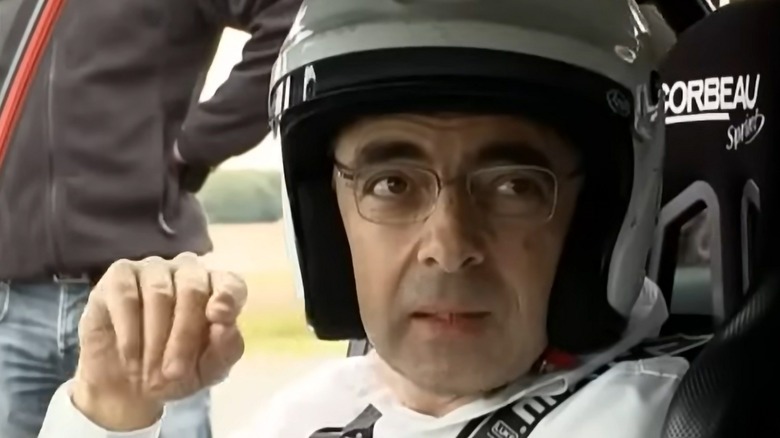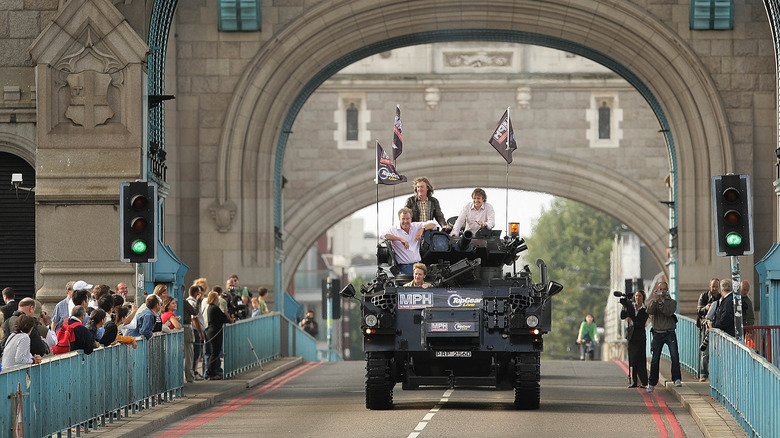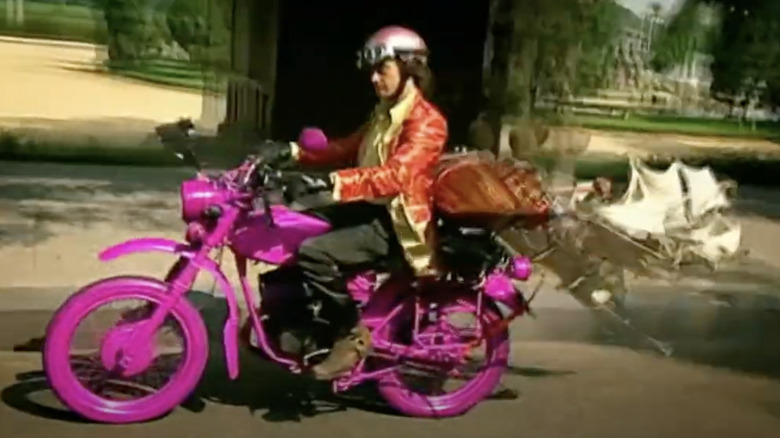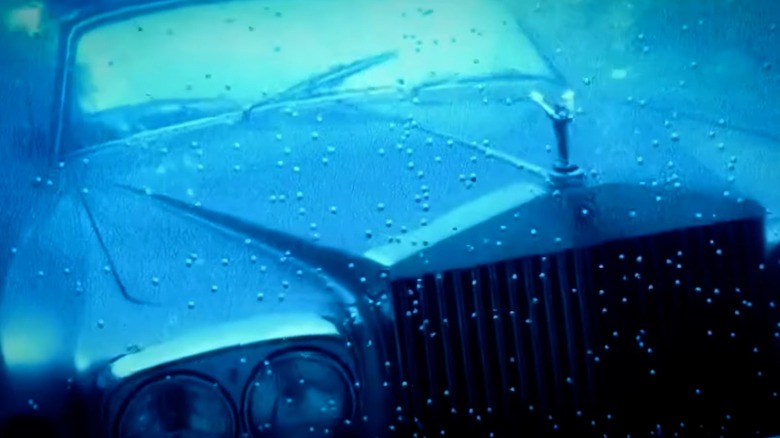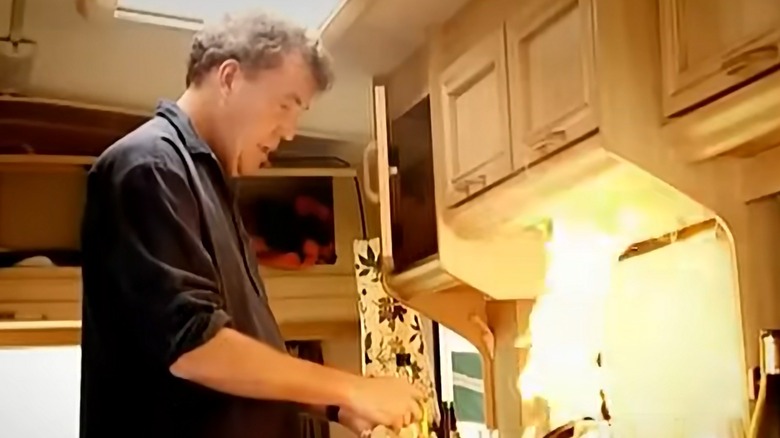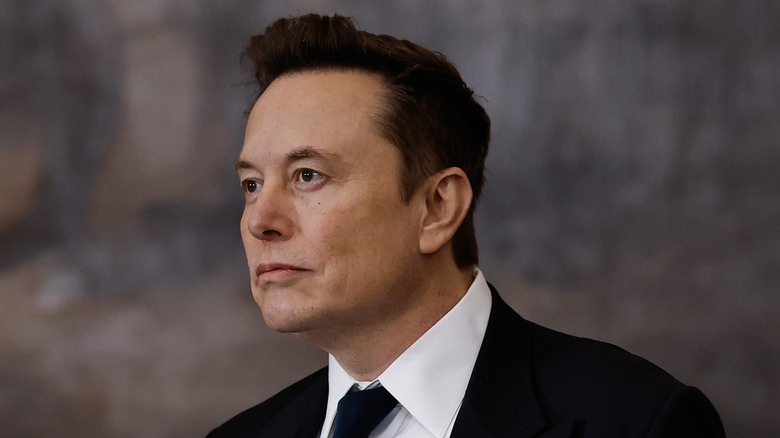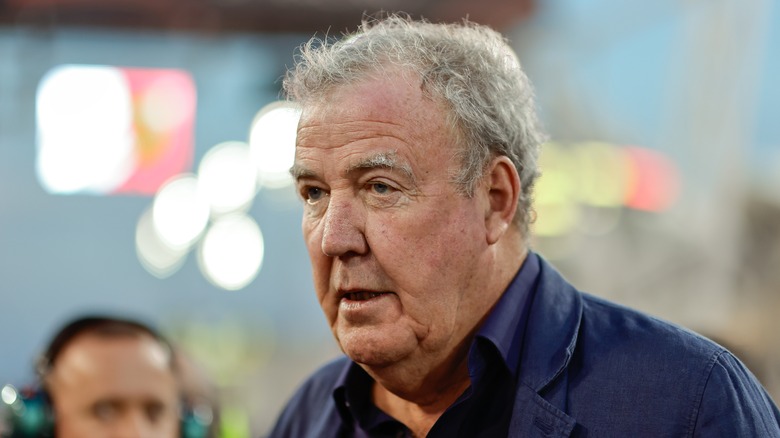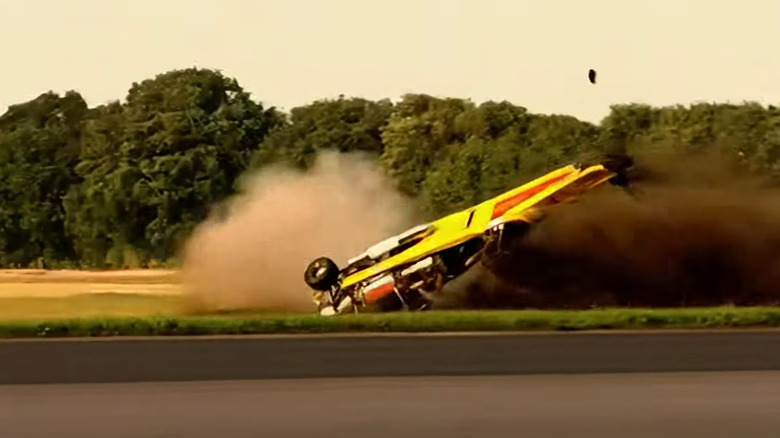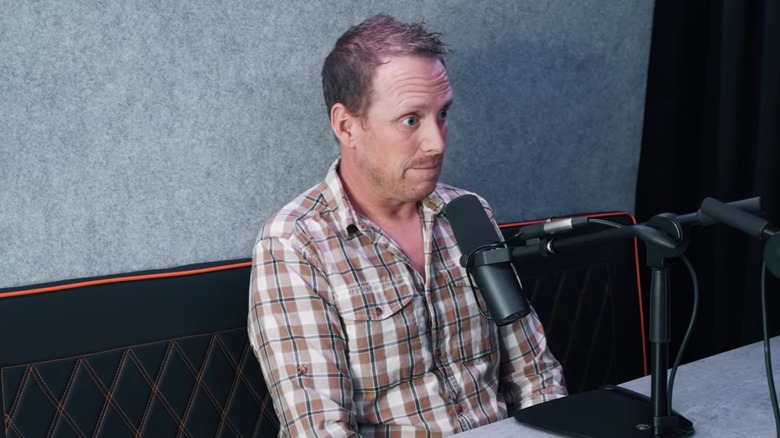What The Cameras Didn't Show Us About Top Gear
From 2002 to 2015 (and again from 2016 to 2023), the BBC gave audiences one of the greatest car-themed programs of all time: "Top Gear." The show might have been a reboot of another program with the same name, but that didn't hold back this "Top Gear." It was full of memorable stunts, and many episodes are must-watches for gearheads. However, "Top Gear" wasn't all British humor and new car smell.
A lot went on behind the scenes, which isn't all that surprising considering how much happened on-camera. A ton of planning went into each episode — not just to arrange the shoots but also to ensure they were safe. And that's to say nothing of the drama that happened between takes and after filming wrapped for a season. Some of these issues were standard for a TV show, while others could have only happened on "Top Gear." These included off-set pranks, the accidental invention of a running gag, and, of course, the actions of one particular host that led to his inevitable sacking.
Here are 10 things the cameras of "Top Gear" didn't catch.
There was more than one Stig
"Top Gear" started with three hosts: Jeremy Clarkson, Richard Hammond, and Jason Dawe — who was quickly replaced by James May. However, the show technically had a fourth, faceless host in the form of "The Stig," whose lack of identity played a major part in his mystique both on and off-camera.
The Stig — who was initially going to be called The Gimp – was characterized by three traits: muteness, anonymity, and racing prowess. The third trait should come as no surprise, as the character was actually professional driver Perry McCarthy in disguise. However, McCarthy's tenure as The Stig only lasted as long as his black racing suit. His incarnation of The Stig was "killed off" and replaced by the more iconic white-suited version, portrayed by Formula Three and Indy Lights racer Ben Collins. And Collins was later replaced by British GT racer Phil Keen. While these three men got to show their obscured faces on television, they weren't the only ones to carry the name "The Stig."
During the first episode of the 13th season, The Stig was finally "revealed" to be F1 Driver Michael Schumacher. However, that was all a stunt; Schumacher never played the character on camera. Plus, should anything happen to the actual Stig — or if a stunt proved too dangerous for him — the "Top Gear" crew always had an understudy ready. Neil Cunningham, who served as a stunt driver in movies such as "James Bond: Quantum of Solace", was also a stand-in Stig for "Top Gear."
Celebrity guests were actually cool
Celebrity cameos in TV shows are always a roll of the dice. The power of their names may bring in viewers, but will these guests actually take an interest in the subject, or are they only there for a paycheck? "Top Gear" didn't seem to have that problem when guests were invited to drive laps around racetracks.
In 2015, the script editor of "Top Gear," Richard Porter, published the tell-all book "And On That Bombshell: Inside the Madness and Genius of TOP GEAR." This book revealed a lot of behind-the-scenes information, including how guests acted when the cameras weren't rolling (via Top Gearbox). In fact, the hosts and crew graded guests on how they arrived at the studio. Low marks were given for using a chauffeur instead of driving themselves, leaving immediately after the shoot, and arriving with an entourage. According to Porter, people such as Chris Evans, Steve Coogan, and Roger Daltrey received "top points" in those respective categories.
The above ratings weren't the only criteria used to judge the perfect guest. The show's executive producer, Andy Wilman, told The Sun that his favorite guest was the songwriter Lionel Richie. Since Richie was the show's first international guest, Wilman thought the crew needed to get him a motorhome. When Richie and his manager were shown the motorhome, the manager was aghast, but Richie thought it was "really funny" because he had dealt with worse while touring the segregated South during the Fifties and Sixties.
Staff invented a running gag
Many shows feature running gags. Technically, The Stig's anonymity and muteness were a major running gag, but "Top Gear" didn't rely on just that one recurring joke. One such running gag was accidentally started by someone audiences never saw on camera.
Depending on when you started watching "Top Gear," whenever one of the hosts set up an amazing or ambitious sequence, skit, or stunt, none of them would take credit. They would all say it was beyond their capabilities. According to Richard Porter's "And On That Bombshell" (via a Reddit post), that recurring joke began with a catering van that, indeed, none of them arranged.
During a 2003 shoot on the Dunsfold Aerodrome tarmac, the crew filmed some scenes with a fast-food truck (a "lorry" in British parlance) serving burgers. During a break, James May broached the question of where the vehicle came from. Turns out one of the show's researchers had arranged for its presence. Both May and Jeremy Clarkson agreed they wouldn't even know how to get such a truck on set. Thus began the running gag where, no matter how impressive a skit got, nobody on camera would take credit. Whether serious or not, May and Clarkson continued to insist for years that they would still be struggling to book the burger van.
Staff played pranks on each other
It's no secret that the hosts of "Top Gear" played plenty of pranks on each other. Who can forget when James May's stereo was glued to permanently belt out rave music or the time Richard Hammond's bike was spray-painted pink? But the stars of the show weren't the only people to join in the fun.
In Richard Porter's "And On That Bombshell," Porter recalled that he once pulled a prank on James May (via Reddit). Sort of. Porter claimed that the show's writing desk was oriented the wrong way. In order to sit at it, staff members had to squeeze between the desk and the wall, often tripping over some wires and potentially unplugging them by accident. During Season 19, Porter finally fixed the situation by turning the desk the right way around. Of course, not everyone saw it that way.
According to Porter's story, when May walked into the writer's room, he instantly knew something was amiss, but he needed a minute to realize what had changed. Porter fessed up, but when Richard Hammond and Jeremy Clarkson saw what had happened, they questioned the wisdom of the change. Why, you may ask? Porter postulated that they feared change — even when something had been done wrong the first time.
Many stunts were faked
If the stars of "Top Gear" loved anything more than driving cars, it was wrecking them. However, crashing vehicles is far more dangerous than the entertainment industry would have you believe. Even low-impact accidents can prove disastrous, so many wrecks on the show were treated with kid gloves.
In 2024, DriveTribe's Mike Fernie went on a road trip with ex-Stig Ben Collins to revisit several "Top Gear" shooting locations. One stop was the Chippy Lido pool, where Jeremy Clarkson drove into the water with a Rolls-Royce. Although, thanks to Fernie's research, we now know that's not exactly the whole truth.
According to Fernie, a Lido representative told him that the show's sacrificial Rolls-Royce was unpowered at the time. The car had been drained of all liquids and ran up some metal rails that had been set up beforehand. The result was less of a stunt and more of a burial. The Rolls-Royce was cruising along fast enough to complete the illusion that it was powered. But here's the real kicker: Collins believes Clarkson wasn't behind the wheel at the time. He postulated that Clarkson dove into the pool after the car submerged, got into the car for an underwater shot, and then got out. According to Fernie, the Lido representative corroborated that claim. It just would have been way too dangerous for Clarkson to be in the car at the time of impact.
Many non-stunts were faked as well
As previously stated, the hosts of "Top Gear" constantly targeted each other with pranks and tomfoolery, but they were also known to try their hands at skits. Usually, these were harmless, but they occasionally delved into dangerous territory. Well, "seemingly" dangerous territory, that is.
One of the more seemingly life-threatening skits took place during a "caravan holiday." The hosts of "Top Gear" drove a camper van to a campsite in Dorset, and during their stay, Jeremy Clarkson decided to cook everyone lunch. Instead of delivering a delicious meal, he accidentally produced a pan fire that set the entire van ablaze. And instead of putting out the fire, the hosts fumbled around like they were in an old "Three Stooges" film. But they were never in any real danger.
In a 2012 article, the London Evening Standard stated that the fire was faked. Well, the flames were real, but the entire situation was nothing more than a controlled skit. According to the outlet, "Top Gear" producers had told the local fire brigade (a British term for a group of firefighters) several weeks in advance, and many crew members and a fire engine were on standby just in case things got out of hand for real. Moreover, the BBC was confident viewers wouldn't be fooled by the scenario due to its "slapstick" nature and "sitcom ending." Given the backlash the BBC received in the aftermath of the episode, unlike the fire, things didn't go according to plan.
Their words have power
While "Top Gear" was a motor show, it was typified by British humor, which often relied on witty and comedic comments/banter. The show's hosts had great charm and the gift of the gab, but their words sometimes came back to bite them.
The hosts of "Top Gear" had a tendency to let loose if they thought a car sucked, which resulted in no shortage of controversies. For instance, during Season 12, Jeremy Clarkson got behind the wheel of a Tesla Roadster. He said the car ran out of power after 55 miles and would take 16 hours to fully charge. Oh, and the brakes failed. Tesla representatives were so outraged they tried to sue the BBC for libel and lost sales. They never forgave the BBC for this scathing critique, as, on a Joe Rogan Experience podcast, Elon Musk claimed that Clarkson wrote the review before the Roadster was dropped off at the "Top Gear" studio.
In the grand scheme of things, upsetting Musk was small potatoes compared to other controversies the hosts of "Top Gear" caused. In 2011, Mexican Ambassador Eduardo Medina-Mora Icaza demanded the BBC apologize after Richard Hammond cruelly called Mexicans "lazy, feckless, flatulent, [and] overweight," and after Jeremy Clarkson and James May described Mexican food as "refried sick" (another word for puke). And in 2012, the hosts insulted all of India with literal toilet humor of the worst kind — they customized a Jaguar with a toilet because, according to Clarkson, "everyone who comes [to India] gets the trots" (British slang for diarrhea).
Jeremy Clarkson was a nightmare off camera
We just went over how all the "Top Gear" hosts have been guilty of saying something offensive at least once, but that was while they were on camera. Jeremy Clarkson, meanwhile, was such a handful that he could be described as, to borrow British slang, "a complete tosser."
In 2015, Clarkson was fired from "Top Gear" after physically assaulting producer Oisin Tymon. This followed multiple controversies between 2011 and 2014, including racist slurs against Asians and Mexicans. He also quite infamously mumbled a unique rendition of "Eeny, meeny, miny, moe" off camera, where he replaced the word "tiger" with the n-word. However, Clarkson denies that particular allegation.
Clarkson's grounds for dismissal weren't limited to just what he said but also how he acted. It is widely accepted that the final straw occurred in March 2015, when the "Top Gear" hosts arrived at the Simonstone Hall Hotel in North Yorkshire. Clarkson was livid over the hotel's food options (or lack thereof) and blamed one of the show's producers, Oisin Tymon. Tymon suffered verbal abuse from Clarkson, including racist remarks regarding his Irish heritage, and was physically assaulted, leaving him with a swollen and bloody lip. To be fair, Clarkson reported himself to the BBC over this altercation, but it was enough to get him sacked. "Top Gear" then went on hiatus while the BBC scrambled to find new hosts. Meanwhile, Amazon launched a similar show with Clarkson, Hammond, and May — The Grand Tour — which ran for eight years before concluding in 2024.
The crash had a lasting impact on Hammond
As we previously stated, many stunts on the show were staged and significantly less dangerous than they appeared. However, in any situation, a lack of danger isn't the same as its complete absence. If you can break your neck walking down the stairs, you can have a horrible car crash under any driving conditions.
On September 20, 2006, Richard Hammond was driving a Vampire dragster at the RAF Elvington airfield. During a final run for extra footage, one of the vehicle's tires blew, causing him to lose control at around 290 mph. He survived but was left in a coma for two weeks with a significant brain injury and inflammation. During recovery, Hammond temporarily regressed to a "childlike state" and became obsessed with Lego. He also developed a sudden taste for celery – it is widely believed he was instinctively self-medicating his brain inflammation with luteolin, which is found in celery.
Unfortunately, the crash might have had some long-lasting effects on Hammond's memory. In a 2023 podcast, he stated that while his short-term memory is intact, his long-term memory is starting to fail. Hammond claimed that he has to "consciously write memories down and work hard to recall them sometimes." He floated the idea that these issues could be the result of aging, lack of sleep, or the onset of "something else," but the possibility remains that his brain injury is catching up with him. Hammond doesn't know the true cause of his memory problems because he's "too scared" to visit a hospital and have his brain checked out.
Most dangerous stunts weren't dangerous thanks to Andy Harriss
Throughout this article, we have discussed many stunts and skits that seemed dangerous on the surface but were actually almost completely safe. However, we have yet to honor the man who helped protect the show's hosts.
Andy Harriss (not to be confused with Andy Harris) served as the health and safety advisor for "Top Gear" from the very beginning, but he also worked on other productions such as "Mission: Impossible." Harriss' job primarily consisted of figuring out everything that could go wrong, planning for worst-case scenarios, and facilitating methods to mitigate any potential damage. Case in point: Jeremy Clarkson.
According to Harriss, Clarkson was a "creative genius" who liked to do his own stuff, and Harriss always had to make sure the shooting locations didn't burn down because of him. For example, while Clarkson was shooting a military vehicle segment in Dorset, Harriss worked behind the scenes to put out bushfires. And during another segment, when Clarkson was supposed to crash a lorry through a brick wall, Harriss worked with stunt coordinator Jim Dow to keep Clarkson safe. They drilled out bits of concrete in the wall to weaken it and make it more easily breached, and Harriss suggested Clarkson recite a safeword after the stunt to confirm he was okay. Clarkson didn't say it afterward, but he did say, "I haven't said the word," which Harriss took as a sign that everything was fine.
